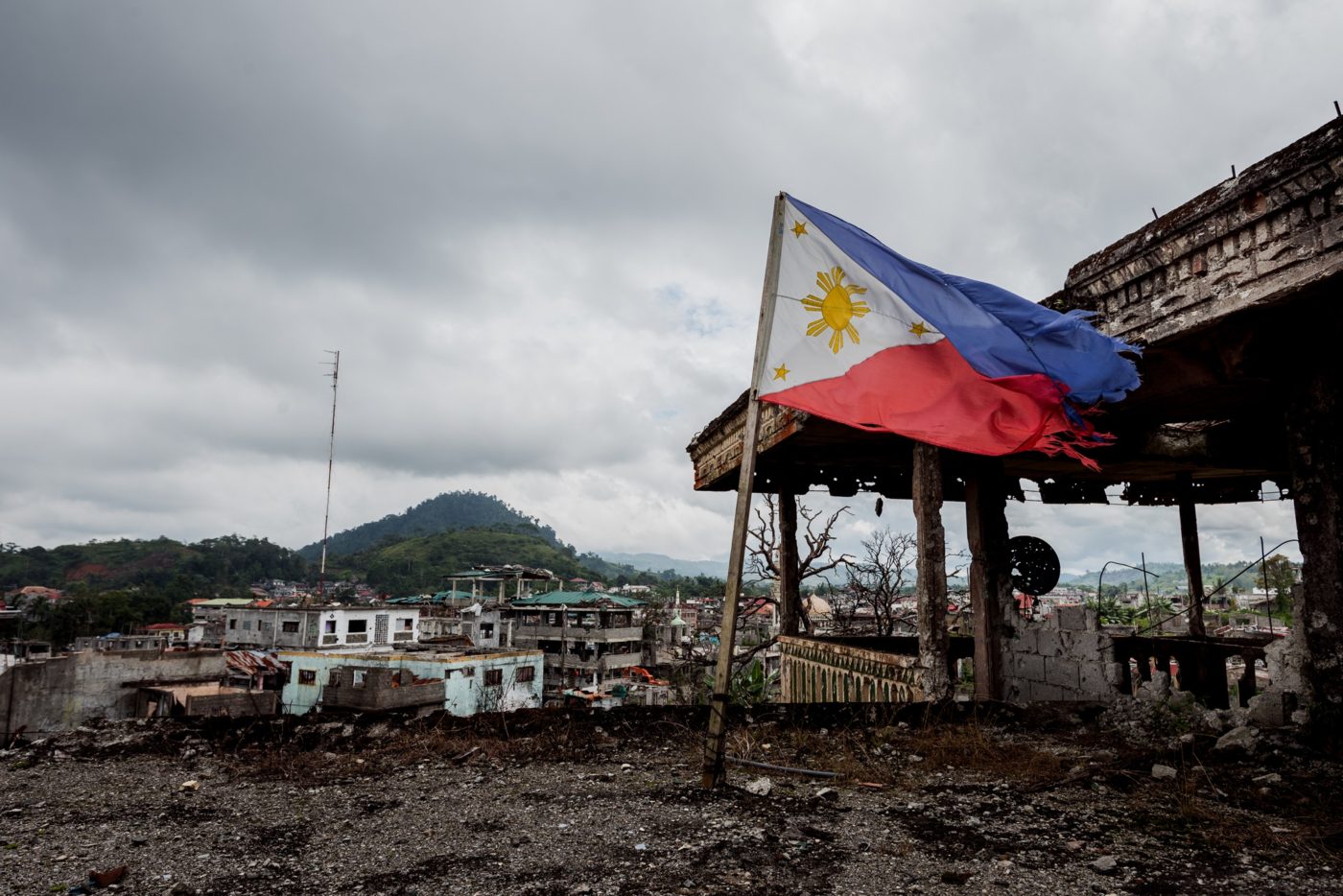EVERYTHING CHANGED when an attempt to capture Isnilon Hapilon, an Abu Sayyaf leader and the Islamic State’s emir in Southeast Asia, flew off the rails. As the mission-gone-awry grew into a full-blown firefight, black Islamic State (IS) flags flew high across the city—an open challenge to the country’s Armed Forces (AFP). Simple black pieces of cloth laid claim to the lives and destinies of the Filipino soldiers who would soon have to meet the challenge, and almost 200 soldiers lost their lives in the effort to liberate Marawi. The AFP found that the IS and the Maute group were prepared for a full-blown siege, and that the raid in search of Hapilon had only hastened the militants’ plan to take Marawi city. They had originally planned to seize the city in time for Ramadan.
A group of Maranao citizens decided to take action, braving Maute checkpoints to conduct search-and-rescue missions throughout the siege. The media dubbed these heroic people the “Suicide Squad” of Marawi. Profoundly untrained and exceedingly brave, the Suicide Squad saved many lives. They saved Christian and Muslim alike—a radical break from the terrorists who threatened to take their city.
Perhaps in opposition to the almost miraculous formation of the Suicide Squad was the inevitable prevalence of war crimes throughout the siege, as reported by Amnesty International. Around 400,000 people in and around Marawi city were displaced by the armed struggle. Abuses of power from both sides of the conflict were recounted in detail by both Maranao citizens and Christian workers who were in Marawi.
It would be impossible to reproduce all of the stories that unfolded in the midst of the five-month-long conflict, a culmination of the unrest that Mindanao has long-standingly experienced. However, interviews with people central to the city’s liberation: the military, the Suicide Squad, and those trapped within the city, might paint a more vivid picture of the five month-long Marawi siege.
War crimes against civilians
- Photo by Zach G. Garcia
- Photo by Janine Torre
A report by Amnesty International details the various war crimes committed by both sides of the Marawi conflict. Hassan* was a driver and shop-owner who saw IS/Maute militants slit the throats of six people. “It was very awful. [The militants] stepped on their heads and they grabbed their hair and then they shot them… After they shot them, [the militants] started shooting in the air,” Hassan told Amnesty International.
Aden* managed to escape Marawi with his family the day the siege broke out. He returned to recover his family’s belongings and encountered a friend who asked him to help evacuate eight Christian workers from his bakeshop. Aden and his friend were then able to gather the workers and were driving to the neighboring city of Iligan when they were stopped by IS/Maute militants. The militants demanded that they recite the Takbeer [Allahu Akbar]. When the Christian civilians could not recite the Muslim prayer, they were forced to form a line and were shot to death.
Justin* was working a construction job on the day that the siege began. Along with six other workers, Justin attempted to escape the danger of the city by jumping into a lake. Three of them made it into the water but Justin was stopped by incoming rebel fire. Justin has not seen his three friends since, and has yet to confirm their survival. He said that he was tortured by AFP soldiers on June 9, 2017, as he attempted a second escape, after he and his friends were accused of being militants and snipers by the military. Justin was beaten with an Armalite rifle, with his hands and feet bound by electrical wire.
Col. Generoso Ponio: The Armed Forces of the Philippines
The new medium of armed conflict is urban warfare. As wars between countries die down and terrorism rises, trenches have been replaced by underground tunnels and abandoned buildings. Marawi was only the latest of wars against terrorism to take place on the battleground of the city.
Commander of the Army 103rd Brigade Colonel Generoso Ponio said that most of the fighting in Marawi was “wall-to-wall and inch-by-inch”. The main challenge in urban warfare is the density of the space or what Ponio called “buildup.” Taking advantage of the nature of the space, Maute terrorists capitalized on the widespread presence of buildings—forcing the war to occur on their terms as they remained concealed. Even well-developed armies such as the United States military have suffered difficulties and losses to largely outnumbered but well-prepared insurgents in the face of wall-to-wall combat.
The AFP was even further disadvantaged as they had no tanks at their disposal, instead they resorted to using airplanes when in need of more fire power. Ponio said, that the use of airplanes came with its own set of challenges: “We had to simulate collisions with buildings to fall them… We had to use airplanes in close-quarter battle. When we would use airplanes and the enemies were too close, some friendly forces were hit as well. But we needed to use the firepower we had.” Another disadvantage was that the soldiers had to go into combat with no protective vests.
Experience in urban warfare was also lacking, as the closest the AFP had come was the Zamboanga siege of 2013, but Ponio said that “the density there wasn’t as intense as Marawi, just bahay kubos and some houses which were scattered. [But here in Marawi,] there are five story buildings with tougher material.” Ponio recounted that casualties would often occur as buildings were being cleared. Soldiers would clear a room only to move on to the next to find a terrorist lying in wait.
165 soldiers died in the effort to take back Marawi, and Ponio inevitably reflects on their death as he remains stationed in Ground Zero where most of the fighting took place: “Losing a soldier is like losing a brother. When you’re with them in battle, and they die, it hurts. But that can’t be avoided, sacrifice is necessary to accomplish missions. In fact, everyone sacrifices, the difference between who lives and who dies [for soldiers in war] is a matter of chance,” he said in Filipino.
Ultimately, their strategy was constriction as Ponio explained that they crowded them until they could take the space, and they eventually succeeded. Despite a number of disadvantages, President Rodrigo Duterte declared Marawi City liberated on October 17, 2017—a day after Omar Maute and Isnilon Hapilon’s corpses were identified. On October 23, 2017, Defense Secretary Delfin Lorenzana announced the end of the battle.
Having emerged victorious after a grueling five months of close combat, Ponio attributes the AFP’s success to the bravery of his soldiers: “We had challenges, but discipline and morale were high in the armed forces. Even in the frontline, facing death, they moved forward. Our soldiers are brave. Despite not having the equipment… They fought,” Ponio said in Filipino.
Mamintal Adiong III: the Suicide Squad
The Saracan, or the Suicide Squad, claim that they entered Ground Zero within the first few days of the siege. As the AFP fought to get past Maute checkpoints, the Suicide Squad risked their lives, petitioning to the Mautes to be allowed entry as first responders. Braving military airstrikes and IS/Maute group firepower, the Saracan conducted search-and-rescue operations for trapped civilians. The Philippine media soon compared them to Syria’s White Helmets. The stark difference between the Suicide Squad and the White Helmets? The Suicide Squad’s volunteers had no training whatsoever. The established White Helmets form a volunteer non-governmental organisation (NGO) funded by a number of Western countries. Meanwhile, the inexperienced members of the Suicide Squad found themselves trying to detonate bombs in the direst of situations. The crossfire, and all its danger, became their territory in the effort to save trapped civilians.
Mamintal Adiong III, now the operations head of the Lanao del Sur Provincial Disaster Risk Reduction and Management Office, was a typical Marawi citizen before the siege broke out. Wanting to pursue a career in film, Adiong went to Manila to take classes in the University of the Philippines Diliman and the De La Salle – College of Saint Benilde. But when the conflict erupted on May 23, 2017, Adiong made his way back to Marawi along with a few others and began conducting unofficial search-and-rescue operations two days later.
Aside from rescuing civilians, the Suicide Squad also pulled corpses from Ground Zero. Adiong said that every part of this was “traumatizing,” as they dealt with deformities and injuries that only war could bring about. A few of their members considered quitting operations after seeing exposed innards and bones on a corpse for the first time. Pulling corpses was also dangerous as IS/Maute rebels used them tactically: often building barricades with bodies and hiding bombs underneath the piles. Suicide Squad members were coached to bring bombs to military experts but Adiong said that there were times when they were too close to detonation and his team members found themselves trying to detonate bombs themselves.
Their most daring operation was the effort to rescue seven or eight Christians who were trapped in the city. Adiong said that the wait in line to get past Maute checkpoints was always tense: “They had around 10 hostages from the AFP. Every time someone would come in, they would ask a hostage if they knew that person. If the hostage said they knew you, you would either be taken hostage as well, or executed. When it was our team’s turn to go in, through the ISIS checkpoint, it took the hostage a while to respond. The hostage might have known our team.”
This inspection was particularly tense as the rescue team had to lie about who they were rescuing. “Luckily, the hostage didn’t say anything. Before that, the team was asked what they were going to do inside. They said they were going to rescue people. ISIS asked who they were rescuing. Were they rescuing Maranaos? Were they rescuing Muslims or Christians? If our team had said Christians they wouldn’t have been allowed to go through. Worst case scenario, they could have been killed. So they said they were rescuing Maranaos,” said Adiong in Filipino.
The mission was extremely successful, the rescue team recovered the trapped Christians and came across even more of them on the way out. The team taught them enough Muslim prayers to get them past Maute checkpoints and they ended up saving a total of 20 Christians from that one mission alone. The Suicide Squad often sought guidance from the AFP in the first few weeks of the conflict. When the military eventually breached Ground Zero, the Suicide Squad worked in conjunction with them as well to continue their search-and-rescue operations.
Over a year has passed since the Marawi siege erupted. Ground Zero remains a ghost town, haunted by the gore it was forced to bear witness to. Even when rehabilitation begins and the ruins decrease, the stories of the siege will live on.
Today, these stories are worth remembering: the bravery of the Filipino soldiers who liberated the city and the miraculous effort, and humanity of the Suicide Squad who risked their lives for their fellow civilians.
*EDITOR’S NOTE: Names from the Amnesty International report were changed in the interest of the interviewees’ safety.






